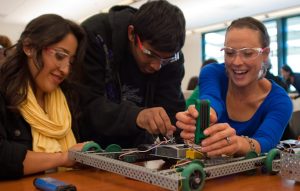29 Centering the Learner
Mariya Gluzman
Simply put, instructional techniques and approaches that focus on the learning needs of individual students are considered learner-centered.
When an instructor chooses to adopt a student-centered perspective, they take into consideration the different educational and sociocultural backgrounds of their students, differences in their language skills and learning abilities, and any disabilities they may have. Being cognizant of these individual differences leads one to develop learning experiences that account for them.
The Glossary of Education Reform — a Maine-based education information nonprofit — offers this informative and concise summary of student-centered learning.
This page by ISTE (International Society for Technology in Education) provides some tips for using technology to deliver student-centered instruction.
Learner-centered techniques can include:
-
-
-
- active learning
- experiential learning
- scaffolding
- social learning
- project-based learning, etc.
-
-
To create student-centered learning experiences one does not need to change their entire syllabus or curriculum. Offering occasional formative assessments and scaffolded activities, creating opportunities for interactivity, or incorporating problem-solving can be very helpful to students.
Student-centered techniques and methodologies
Below, several common student-centered instructional techniques are discussed, briefly. Many of the assignment and activity samples shared in this publication will reflect the techniques discussed here.
Scaffolding
In education, scaffolding refers to providing different kinds of instructional support as students practice their skills and work toward completing assignments independently. Scaffolding can be anything from simply taking a larger assignment, chunking it up, and providing instructions on completing each piece and then on putting all the pieces together, to offering samples and templates to help students understand how to complete certain activities.
Here is a YouTube video demo of a scaffolded activity aimed at helping students master close reading skills — a set of skills fundamental to completing HUM 300 courses successfully.
Experiential Learning
Experiential learning, in its most basic form, is learning by doing. It involves practical, hands-on learning activities and incorporates reflection on one’s practice.
Boston University’s Center for Teaching & Learning offers this comprehensive overview of experiential learning.
Lab work, qualitative research projects, new stories and reports, reviews, mock trials, and moot courts are just some examples of assignments and activities that encompass experiential learning.
Active Learning
Active learning is about engaging students as active participants in the process of learning a skill or mastering course subject matter.
When students engage with the course material, apply what they learn to solve problems, or work collaboratively to master new skills, their learning is considered to be active.
Being active participants in their learning allows students to explore, ask and answer questions, hone various skills, contextualize the course subject matter, and make their learning authentic.
Passive learning, on the other hand, refers to techniques that cast students as spectators or receivers of information. While some transmission-based techniques are invaluable and should not be wholly discarded, it is important for students to take an active role in their learning and practice what they learn under the guidance of their instructors.
Active learning activities can be those that students complete independently or collaboratively. These activities can be graded or ungraded, short or long, scaffolded or not.
The table below classifies several common classroom activities as active or passive. Alternating between active and passive activities throughout a lesson can create a more engaging learning experience for the students.
| Active | Passive |
|---|---|
| Guided close reading activity
The instructor demonstrates how to engage with a text on a deeper level. Students practice close reading skills by reading specific passages, extracting information from them, asking questions about the text, and offering interpretations of the passages.
|
Lecture
The instructor is transmitting information to students. Students may or may not be forming a relationship with the material. The instructor offers their own interpretation of the material without much room for students to construct their own meaning. Students often absorb information given by the instructor during a lecture without much critical thinking. |
| Moderated discussion
Students are forced to think about the material on a deeper level, formulate and defend their own opinions, and engage in civil discourse with others. |
Q & A (students asking questions)
The instructor is seen as a knowledge bank. Students accept what the instructor says with little scrutiny. Students may or may not construct their own meaning. |